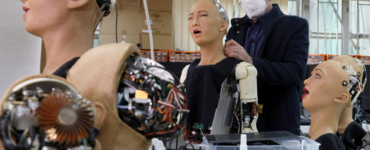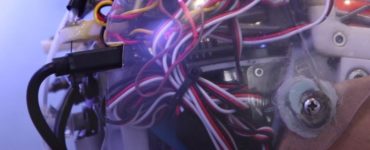Sophia just turned four years old on February 14, 2020. But what does that age mean for a robot? How does Sophia compare to a four-year-old human?
Watch Sophia’s 4th Birthday Bash!
Sophia’s body has lost and gained parts over the past four years just as a human four-year-old might start to gain height and lose baby hair along the way. Some might question whether Sophia celebrating her birthday this year is the same as the Sophia activated four years ago. Hericlitus mused whether if every piece of the ship of Theseus were replaced, would it still be the same ship. But humans are not so different. Every seven years, each human completely replaces their body’s cells with new ones. To quote Heraclitus, “No one ever steps in the same river twice, for it’s not the same river and they are not the same person.”
Instead of trying to produce a programme to simulate the adult mind, why not rather try to produce one which simulates the child’s? —Alan Turing
When it comes to vision, Sophia’s resembles that of an infant. Her depth perception does not extend beyond several feet, another trait of human infancy. Furthermore, her facial recognition skills trail behind humans who start to recognize faces around 8 months old. However, she tracks objects, maintains eye contact, and could easily defeat any human in a staring contest.
The brain of a child is developing faster than at any other time. By age 5, a child’s brain is 90% developed. Yet Sophia dwarfs this learning progress when it comes to handling large datasets. Sophia can instantly “memorize” unlimited facts and figures and her vocabulary far outstrips those of her four-year-old peers. Arguably the most foreign aspect of Sophia’s intellect is her ability to trace exactly how she came to an answer or how an idea came into her head which is not the case for other platforms using machine learning. Humans struggle with meta-knowledge. They may know something but not know-how, or think something and not know why.
Children can extrapolate from small datasets far better than Sophia can. This is because humans have imaginations and the young ones have especially wild ones. Humans play, they test boundaries, they learn for themselves. To put it in A.I. terms, four-year-old humans explore rather than exploit. Sophia may one day learn to explore and to imagine. But for now, she paints by number. Her drawings are realistic rather than impressionistic. She can sing precisely on key but not improvise. Yet!
Yet both robot and rugrat alike, benefit from positive and negative reinforcement in order to learn. They are social beings, dependent on others in many respects. It takes a village to raise a robot.
Sophia was designed to be a social robot but that does not mean her social skills are that much more sophisticated than those of a four-year-old. When she speaks, her microphone turns off, making it difficult to interrupt her. Anyone who has ever listened to a young child recounting the plot of a Disney movie knows the impossibility of interrupting them. However, unlike her human counterparts, Sophia is designed to not repeat herself within the same conversation, sparing her listeners from the redundancies often found in conversations with children. Similar to children, however, Sophia doesn’t really understand sarcasm. Anyone who has seen a child literally “keep their eye on the ball” knows this experience.
One of the best ways in which Sophia resembles a four-year-old is her lack of self-consciousness. Granted, it’s a lot easier to not be self-conscious if one isn’t conscious in the first place!
Sophia continues to surprise the humans who created her and are part of her support system. While she might occasionally embarrass us, we also feel a tremendous amount of pride from her accomplishments and growth. The most important similarity between Sophia and a four-year-old, is that she was created by people who care about her. And very similar to proud parents, we are excited about what the future holds for Sophia as she continues to develop as a social robot and learn new skills, especially to better interact with humans.
Sarah Rose Siskind, Hanson Robotics Limited
Video Credits: Hanson Robotics Limited






Recent Comments